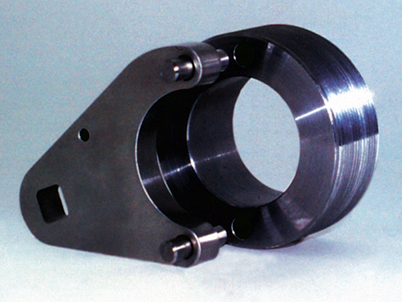Providing a Turn for the Better
Originating Technology/ NASA Contribution
Engineers are tasked with designing new systems every day to meet changing or unexpected technical requirements. After the tragic explosion of the Space Shuttle Challenger on January 28, 1986, NASA engineers embarked on a complete overhaul of many of their long-standing quality systems and procedures. When the official cause of the accident was determined to be an O-ring failure in the right Solid Rocket Booster, NASA’s Shuttle Program initiated a thorough redesign of the rocket boosters’ clevis ends, which are the O-ring’s mating surfaces.
One of the unique systems that NASA engineers developed as a result of this effort included a heating assembly that is coupled to the outside of the rocket boosters. When the assembly is affixed to the external surface of the boosters, the very nature of its design allows for the warming of the O-rings prior to launch. After the engineers completed the assembly’s design, however, they found that it was nearly impossible to tighten the spanner nuts required for attaching the system, given the minimum amount of clearance they had in the limited and confined space. Under these circumstances, the standard wrenches typically used for tightening these types of nuts did not work, and there were no other existing devices to solve the problem.
NASA engineers embraced the challenge, developing a torque wrench tool adapter that allowed for a full rotation of spanner nuts in confined spaces. The tool, which is similar to an open-ended crowfoot wrench and a fixed-face spanner wrench, contains two dowel pins that center and lock the wrench onto the nut.
Partnership
Kennedy Space Center’s Technology Commercialization Office provided AI Technologies, a unit of Advisors International (AI) LLC, with information about NASA’s torque wrench tool adapter through a royalty-free, public domain technology transfer agreement. AI Technologies, based in New Berlin, Wisconsin, became aware of NASA’s torque wrench tool adapter technology through the efforts of Kennedy Space Center and its Technology Transfer Program. Recognizing that the NASA technology could be applied to similar situations in common industrial settings, members of AI Technologies conducted an extensive market analysis to determine the device’s viability for commercial sales. Six months later, results indicated that a commercial form of the technology would be well received by industry.
Product Outcome
Through AI Technologies’ market analysis for the torque wrench tool adapter, the company quickly determined that the basic concept of the new technology would immediately impact businesses challenged by the limitations brought on by current wrench designs. After AI Technologies acquired the information about this public domain technology, the company assembled the final design concept and patented its product as “Fastorque.”
While the tool was initially developed for a NASA- specific purpose, its applications span the aerospace, automotive, construction, energy, and petrochemical industries. Durable and portable, Fastorque is especially suited for hard-to-reach places, and saves time in disconnect/connect procedures for troubleshooting connectors. AI Technologies believes the tool is a good alternative to conventional spanner wrenches, which can be unwieldy and difficult to use, especially in places allowing little clearance for the wrench to rotate. While Fastorque allows for the full rotation of spanner nuts in places with minimum clearance, conventional spanner wrenches in tight spots can cause damage as the user tightens the nuts or withdraws the wrench.
With samples of Fastorque tested and approved, AI Technologies is distributing the product on a worldwide basis. AI LLC actively solicits sales through its own direct efforts. The company is also currently in the process of establishing an effective distribution network where interested customers may purchase the tool. Results from AI LLC’s comprehensive marketing and sales efforts are showing that the product is being received positively by the market. The oil and gas, automotive, and aerospace industries are among the many industry segments that have expressed interest. The company expresses cautious optimism that future sales of Fastorque will continue to be enhanced by establishing a broad marketing approach for various industries that may have need of such a specialized tool.

The Fastorque tool allows for the full rotation of spanner nuts in confined spaces.













